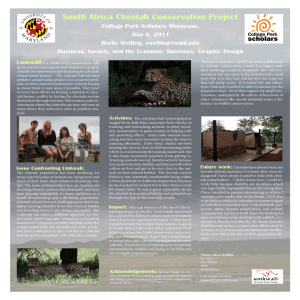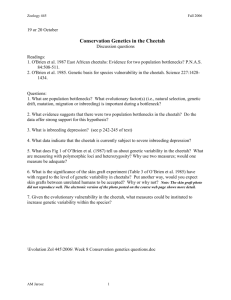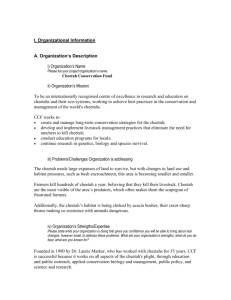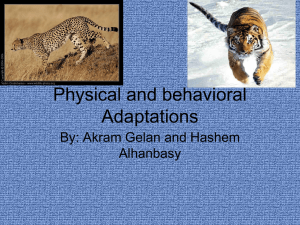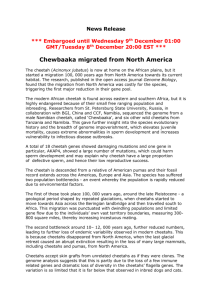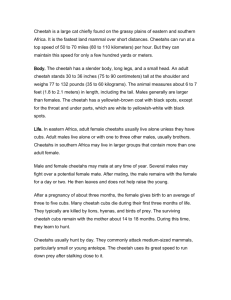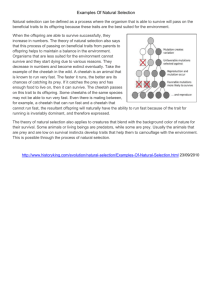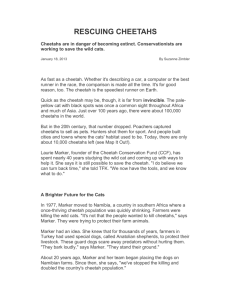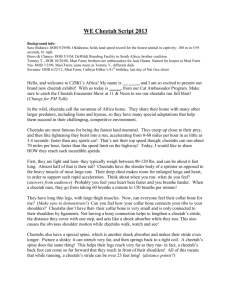Final Report - The Rufford Foundation
advertisement
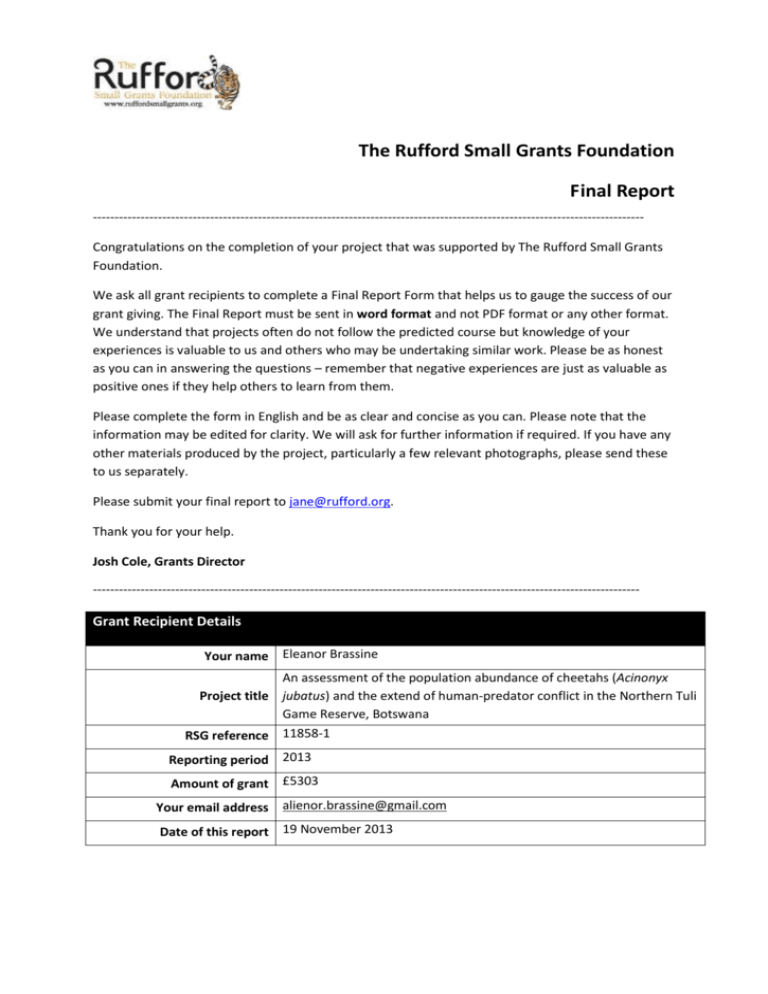
The Rufford Small Grants Foundation Final Report ------------------------------------------------------------------------------------------------------------------------------Congratulations on the completion of your project that was supported by The Rufford Small Grants Foundation. We ask all grant recipients to complete a Final Report Form that helps us to gauge the success of our grant giving. The Final Report must be sent in word format and not PDF format or any other format. We understand that projects often do not follow the predicted course but knowledge of your experiences is valuable to us and others who may be undertaking similar work. Please be as honest as you can in answering the questions – remember that negative experiences are just as valuable as positive ones if they help others to learn from them. Please complete the form in English and be as clear and concise as you can. Please note that the information may be edited for clarity. We will ask for further information if required. If you have any other materials produced by the project, particularly a few relevant photographs, please send these to us separately. Please submit your final report to jane@rufford.org. Thank you for your help. Josh Cole, Grants Director ------------------------------------------------------------------------------------------------------------------------------ Grant Recipient Details Your name Eleanor Brassine An assessment of the population abundance of cheetahs (Acinonyx Project title jubatus) and the extend of human-predator conflict in the Northern Tuli Game Reserve, Botswana RSG reference 11858-1 Reporting period 2013 Amount of grant £5303 Your email address alienor.brassine@gmail.com Date of this report 19 November 2013 1. Please indicate the level of achievement of the project’s original objectives and include any relevant comments on factors affecting this. Objective Not achieved Partially achieved Estimate the current population size and structure of the cheetah population Yes Demonstrate the effectiveness, including relative costs in terms of time and money, of photographic survey for estimating cryptic carnivore numbers. Determine the range use of the population, including preliminary estimates of habitat preference; home range sizes and overlap, and areas utilised. Assess human-cheetah conflict Yes Fully achieve d Comments Field work has been completed; we are still in the process of analysing the data which we believe will give accurate estimates of the population size. The photographic survey is ongoing. The effectiveness of the survey will be assessed once all photographic records have been collated and analysed. Yes Although the sample size was limited, we were able to discern the home range size of a female cheetah. We will also be using the locations of sightings data to contribute to range use estimates. Yes We were able to successfully determine the extent of humancheetah conflict beyond the boundaries of the reserve as well as identify possible solutions. 2. Please explain any unforeseen difficulties that arose during the project and how these were tackled (if relevant). A trial camera trap survey was implemented whereby camera traps were deployed randomly in a systematic grid. A random sampling design was used to reduce bias in abundance indices and spacing between the units was chosen to assure that no cheetah could go undetected. However, the survey produced very few cheetah captures, hence the survey method was inefficient for the capture of cheetahs and thus an alternative camera trapping method was designed. In the interim a pilot survey was conducted placing camera traps at sites of known cheetah activity. Field guides have observed cheetahs using certain scent marking posts and with their assistance a total of 102 scent marking posts were identified and mapped. The second survey was highly successful and photographs will be used to identify individuals from spot patterns and capture histories for each cheetah identified will be established. In addition, photographs obtained will contribute to our photographic record of individual animals in the population increasing the individual cheetah database and establishing more concrete population numbers 3. Briefly describe the three most important outcomes of your project. Information gained from this project will aid in a better understanding of the status and population dynamics for the cheetahs in the Northern Tuli Game Reserve and contribute towards a more informed and reliable conservation management plan. Our results will also contribute to a better understanding of the current level of conflicts with livestock farmers in an effort to reduce human-induced mortalities and develop effective mitigation strategies to assist in the conservation of cheetahs outside of the reserve borders. Research findings will be published in the form of a MSc dissertation and journal publications which will contribute towards the Rangewide Conservation Planning Process for Cheetah in Southern Africa. Furthermore all papers and reports will be made available to the Department of Wildlife and National Parks of Botswana (DWNP) and stakeholders of NOTUGRE. 4. Briefly describe the involvement of local communities and how they have benefitted from the project (if relevant). Local field guides and villagers assisted in the project, learning about the importance of conservation and the purpose of research. In addition, assistants learned skills in interviewing techniques and photography. During the questionnaire survey we took the opportunity to advise on livestock loss prevention, how to identify the more common predators and the status of cheetah and their conservation. The Northern Tuli Cheetah Project participated in Children in The Wilderness Programs. Children from the local communities, namely Mothlabaneng and Lentswe le Moriti, were invited to spend five nights in Mashatu Nature Reserve’s Tent Camp (Two camps with 16 children at each). Children in the Wilderness (CITW) is a programme that aims to increase children’s knowledge of natural environments and sustainable conservation. The programme focuses on environmental education, leadership skills and recreation. Local children also have a chance to view wild animals up close and learn about their behaviour. We have recently participated in an extremely successful and innovative wildlife awareness day. Researchers of NOTUGRE were invited to assist with the 1st Annual Mothlabaneng Wildlife Awareness Day. The Wildlife Awareness Day was hosted by The Mothlabaneng Village Development Committee and supported by members of surrounding wildlife reserves. The event aimed at promoting the value of wildlife to the Molema Community and to have an informative day for local residents, providing both entertainment and education. Presentations were given by local conservation managers and guest speakers. Information stalls were also erected, providing information and displays of research in the area, the impact of poaching/illegal hunting, career opportunities in tourism and means to reduce livestock loss to predators through improved farm management. The day was extremely well attended with over 200 people from local communities (Mothlabaneng, Lentswe le Moriti and Mathathane) as well as delegates and representatives from a number of government departments and representatives from NOTUGRE and other surrounding reserves. 5. Are there any plans to continue this work? Yes, the project is ongoing. We also hope to further develop the project looking at other aspects including the diet of this free roaming cheetah population. 6. How do you plan to share the results of your work with others? Through the production of scientific and popular articles, the presentation of results at scientific meetings and stakeholder workshops. Furthermore throughout the project the principal researcher offered specialist research drives and presentations of the research to international clientele. The findings of the research will also be displayed in the reserve’s camp. 7. Timescale: Over what period was the RSG used? How does this compare to the anticipated or actual length of the project? 1 year; this period covered the field work period of the project. It is anticipated for the project to run for a further year with possible further development. 8. Budget: Please provide a breakdown of budgeted versus actual expenditure and the reasons for any differences. All figures should be in £ sterling, indicating the local exchange rate used. Exchange rate: £1 = R 12.63 Item Compact digital cameras Fuel Budgeted Amount 1495 Actual Amount 903 Difference Comments +592 1819 2331 -512 Only three items were purchased. The other two cameras were purchased through additional funding Remaining funds were spent on fuel that amounted to more than anticipated Printing and copying 180 45 +135 Batteries 190 233 -43 Travelling to and from study site 1137 569 +568 Camera traps 0 693 -693 Rhodes University administration fee 482 530 -48 5303 0 Total 5303 We manage to maintain this item under budget Additional batteries were required to run camera traps Travel to and from the university was kept to only one trip to lower expenses. Budget was adjusted and reallocated for camera traps to meet some of the developing changes in my field work. Rhodes University has a 10% administration fee on all funds and this is influenced by exchange rates. 9. Looking ahead, what do you feel are the important next steps? Initially to collate all data collected so far, run necessary statistical analyses and produce results of my work as well as providing necessary recommendations to stakeholders. 10. Did you use the RSGF logo in any materials produced in relation to this project? Did the RSGF receive any publicity during the course of your work? Yes, it was used in all public presentation of the project. PICTURES

